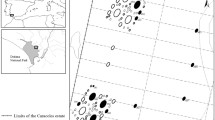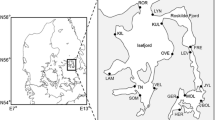Summary
Allele frequencies in natural T. californicus populations were perturbed by introduction of copepods from neighboring differentiated populations. In five experiments, the Gpt F allele was introduced into single recipient pools at a frequency of approximately 20%. In each case, the introduced allele declined to low frequencies (<3%) in less than one month, apparently due to dilution by residents of other pools on the same outcrop. In a larger scale experiment, the Pgi F was introduced into four pools on a single small rock outcrop; all pools on the outcrop were subsequently monitored. While the allele frequency fell from approximately 40% to 10% during the first six weeks after the transplant, no further change in frequency was observed for the duration of the experiment (16 months). Within six weeks some spread of the allele to non-recipient pools on the same outcrop was observed; by eight months, allele frequencies in all pools on the outcrop were similar. Hence, despite the extensive turnover of subpopulations as single pools evaporate or are washed out, genetic homogeneity and stability of entire outcrops are maintained via extensive inter-pool gene flow; this contrasts sharply with the highly restricted levels of inter-outcrop gene flow.
Similar content being viewed by others
References
Barker JSF, East PD (1980) Evidence for selection following perturbation of allozyme frequencies in a natural population of Drosophila. Nature 284:166–168
Bozic B (1975) Detection actometrique d'un facteur d'inter-attraction chez Tigriopus (Crustaces, Copepodes, Harpacticoides). Bull Soc Zool Fr 100:305–311
Burton RS, Feldman MW (1981) Population genetics of Tigriopus californicus. II. Differentiation among neighboring populations. Evolution 35:1192–1205
Burton RS, Feldman MW (1982) Population genetics of coastal and estuarine invertebrates: Does larval behavior influence population structure? In: Kennedy VS (ed) Estuarine Comparisons. Academic Press, New York, p 537–551
Burton RS, Feldman MW, Curtsinger JW (1979) Population genetics of Tigriopus californicus (Copepoda: Harpacticoida). I. Population structure along the central California coast. Mar Ecol Prog Ser 1:29–39
Dethier MN (1980) Tidepools as refuges: predation and the limits of the harpacticoid copepod Tigriopus californicus (Baker). J Exp Mar Biol Ecol 42:99–111
Vittor A (1971) Effects of the environment on fittness-related life history characters in Tigriopus californicus. Ph.D. dissertation, University of Oregon
Author information
Authors and Affiliations
Rights and permissions
About this article
Cite this article
Burton, R.S., Swisher, S.G. Population structure of the intertidal copepod Tigriopus californicus as revealed by field manipulation of allele frequencies. Oecologia 65, 108–111 (1984). https://doi.org/10.1007/BF00384471
Received:
Issue Date:
DOI: https://doi.org/10.1007/BF00384471




